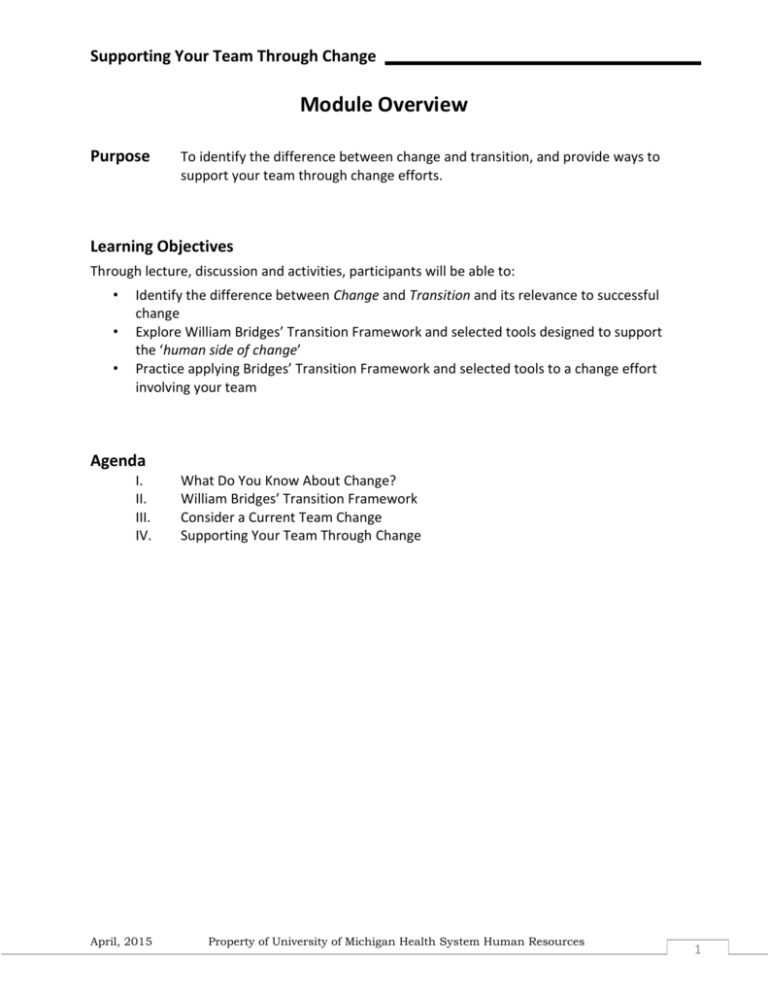Supporting Your Team Through Change - UMMS Wiki
advertisement

Supporting Your Team Through Change Module Overview Purpose To identify the difference between change and transition, and provide ways to support your team through change efforts. Learning Objectives Through lecture, discussion and activities, participants will be able to: • • • Identify the difference between Change and Transition and its relevance to successful change Explore William Bridges’ Transition Framework and selected tools designed to support the ‘human side of change’ Practice applying Bridges’ Transition Framework and selected tools to a change effort involving your team Agenda I. II. III. IV. April, 2015 What Do You Know About Change? William Bridges’ Transition Framework Consider a Current Team Change Supporting Your Team Through Change Property of University of Michigan Health System Human Resources 1 Supporting Your Team Through Change Types of Change Starting School Ending School Marriage Divorce New Job Loss of loved ones Job Relocation Moving Leaving Family Health Concerns Care-giving Responsibilities How do I React to Change? 2 Property of University of Michigan Health System Human Resources April, 2015 Supporting Your Team Through Change What I (Already) Know About Change 1. Individual Reflection (5 mins): Reflect upon a major change that you’ve made in your life. It could be a personal life change or a workplace change. a. As you made this change, what ended? (e.g. identity, status, influence, control, security, relationships) b. How did you feel? (e.g. angry, scared, disappointed, lonely, excited, relieved, curious) c. What helped (or might have helped) to make the change easier? (e.g. more information, more support, knowing where to get help) 2. Triads Sharing (20 mins) a. Team up with two others to share your answers to question 1. Prepare to share some (non-private) thoughts with the larger group. 3. Whole Group Share (5 mins) a. What do we already know about change? b. How does this help you think about supporting your teams through change? Notes: April, 2015 Property of University of Michigan Health System Human Resources 3 Supporting Your Team Through Change “Managing Transitions: Making the Most of Change” William Bridges’ helpful guide, 1st published 1991, offers a framework for understanding why change can be hard and offers many tools designed to: Bridges’ key overarching message involves distinguishing CHANGE from TRANSITION Change is and ‘Event’: it is situational and external to us. In Contrast, Transition is a gradual psychological reorientation: it happens internally as we try to adapt to change. 4 Property of University of Michigan Health System Human Resources April, 2015 Supporting Your Team Through Change You Can’t Talk about Change without Transition Bridges highlighted that… It’s the transition, not the change that people often resist, because… Potential loss of identity and/or all that’s familiar Disorientation, uncertainty about the future Risk of failing in a new situation April, 2015 Property of University of Michigan Health System Human Resources 5 Supporting Your Team Through Change Endings You have to end before you can begin! Leader’s role during Endings… • • • • • 6 Help others let go of ‘the old way of doing things’ Understand the reason for the Change Be supportive to self, team members, and other supervisors and colleagues Provide time to celebrate the past, say goodbye Establish an opportunity to take a piece of the past with them Property of University of Michigan Health System Human Resources April, 2015 Supporting Your Team Through Change Neutral Zone Getting through the in-between time! Leader’s role during Endings… • Provide support through the ‘in-between time’ • Continue empathy/support • Use the time creatively • Maintain frequent updates April, 2015 Property of University of Michigan Health System Human Resources 7 Supporting Your Team Through Change New Beginnings Embarking on New Beginnings! Leader’s role during Endings… • Encourage adaption to ‘the new way(s)’ • Build curiosity • Celebrate small successes • Reward flexibility and responsiveness 8 Property of University of Michigan Health System Human Resources April, 2015 Supporting Your Team Through Change How Do Work Changes Come to Us? Often from Senior Leadership A need for change is identified A case for change is made An outline and timeline is sent… Change • Practical event • New situation • Happens on schedule • Result of decisions Transition • Psychological process • New relations/ identity • Internal ‘heart’ clock • Result of process Your role as a Leader when change comes to you… Share the Case for Change Acknowledge Response / Challenges Remove All Barriers and Support Your Teams Recognize, Appreciate, Encourage Progress Check-In Often and Follow Up Promptly If we only focus on Change We tend to focus on ‘logistics’ and things we need to do It’s practical and necessary but doesn’t support how people are experiencing change how they feel and what they’re making of it all It doesn’t reach ‘the heart’ of the matter April, 2015 Property of University of Michigan Health System Human Resources 9 Supporting Your Team Through Change My Team Change Individual Reflection (5 mins): Identify a change effort that you and your team are going through or have been through. Consider the following questions: 1. What is/was the reason/rationale for the change? 2. How will /or has the change affected your team? 3. How will/has the organization benefit(ed) from the change? 4. Do you/did you have a plan for rolling out the change or was one shared with you? 5. What are/were the expected outcomes? 6. What kind of training and support will/did your team need? 7. Have/Did you engage(d) your team in helping with the change effort, if so how? Table Group Discussion (20 mins): Using this information, each share/discuss the change effort that you will focus on today. 10 Property of University of Michigan Health System Human Resources April, 2015 Supporting Your Team Through Change Where Are You & Your Team? Transition Map Notes: April, 2015 Property of University of Michigan Health System Human Resources 11 Supporting Your Team Through Change Listening for Words and Phrases Instructions: What are you/ were you hearing in your work area? Review the examples below for similarities you may recognize and check the box to the right accordingly. Phrase What People May be Saying Not Yet in Transition Endings Neutral Zone New Beginnings Finished with Transition 12 Check if You’ve Heard This (or something similar) Until they tell us what the changes are, we have no way of telling how they might affect us. This is no big deal. We’ve been through this before. This is just another one of those management changes that doesn’t affect us at our level. This is ridiculous! Who thought this up? It makes no sense! This isn’t the company I signed on with. There was nothing wrong with the way we were doing things. Why are they changing it? Sometimes it seems like there’s no-one driving this train. It feels like we’re just marking time, waiting for somebody to do something – things are on hold. I feel totally disconnected and no-one even cares. It really was upsetting at first, but I feel pretty good now. Did you see the sales figures? We’re making out targets again! When you get used to the new program, it isn’t half bad. It really was upsetting at first, but I feel pretty good now. Did you see the sales figures? We’re making our targets again! It took me awhile to feel part of the team, but now I really feel like I’m part of things. Property of University of Michigan Health System Human Resources April, 2015 Supporting Your Team Through Change Three Keys to Successful Transition 1. Information – Communicate Often, Then Some More 2. Engagement – Transition Team and Everyone 3. Support– Empathy, Training, Coaching, Resources Endings: • • • • Is the reason for the change clear? Do team members understand how it may affect their role(s) and responsibilities? Have you shared a team plan of next steps? Trainings? Expected outcomes? Have you shared your communication strategy for providing regular updates? Share/Delegate/Empower • Transition Team • Communication Plan • Feedback Loops • Team Champions • Training Leads Creating a Transition Team 1. Select members or seek volunteers carefully 2. Designate a Team Lead and Sub Lead 3. Include at least one ‘naysayer’/informal leader 4. Clarify roles and responsibilities 5. Clarify communication loops/flows/frequency 6. Clarify boundaries, role term, replacement 7. Implement before roll out! April, 2015 Property of University of Michigan Health System Human Resources 13 Supporting Your Team Through Change Neutral Zone: 1. Communicate the 2 Cs: • Connection – ‘no staff member left behind’ • Concern – for losses 2. Communicate Information • Reiterate the Case for Change • Clarify Any New Roles/Responsibilities • Share Updates / Adjustments to the Plan Enhancing Creativity: Encourage experimentation / risk taking Encourage and support trust Encourage learning more about the change Encourage ‘out-of-the-box’ thinking/ideas Remember to laugh…and don’t forget the pizza! New Beginnings: • Fine tune plan and communicate changes • Ensure early successes – ‘low hanging fruit’ • Appreciate flexibility and responsiveness • Communicate, communicate, communicate! 14 Property of University of Michigan Health System Human Resources April, 2015 Supporting Your Team Through Change Summary: Bridges’ 7 Principles of Transition Management 1. You have to end before you begin 2. Between the ending and the beginning, there is a hiatus 3. That hiatus – or transition can be creative 4. Transition is developmental 5. Transition is also a source of renewal 6. People go through transition at different speeds 7. Most organizations are running a “transition deficit” April, 2015 Property of University of Michigan Health System Human Resources 15







